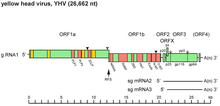| Tipravirus | |
|---|---|

| |
| Roniviridae virion | |

| |
| Yellow head virus genome | |
| Virus classification | |
| (unranked): | Virus |
| Realm: | Riboviria |
| Kingdom: | Orthornavirae |
| Phylum: | Pisuviricota |
| Class: | Pisoniviricetes |
| Order: | Nidovirales |
| Family: | Roniviridae |
| Genus: | Okavirus |
| Subgenus: | Tipravirus |
Okavirus is a genus of enveloped positive-strand RNA viruses which infect crustaceans.[1] Host organisms are mostly shrimp. It is the only genus in the family Roniviridae.[2] Viruses associated with the genus include: gill-associated virus (GAV) which causes reddening, biofouling with exoparasites, emaciation, and massive mortality; and yellow head virus (YHV) which causes yellow head, arrest of feeding, and massive mortality.[1][3] The name is derived from the 'Oka' or lymphoid organ in which the viruses are commonly detected and in which pathology occurs during acute infections. Lymphoid organs are anatomical structures common to penaeid shrimp. There are three species in this genus.[1]
Structure
Viruses in the genus Okavirus are enveloped, with bacilliform geometries, and helical symmetry. The diameter is around 20–30 nm.[1][3]
Genome
Genomes are linear and non-segmented, around 26 kb in length.[1][3]
Life cycle
Entry into the host cell is achieved by attachment to host receptors, which mediates endocytosis. Replication follows the positive stranded RNA virus replication model. Positive stranded RNA virus transcription is the method of transcription. Crustaceans and mostly prawns serve as the natural host. Transmission routes are ingestion.[1][3]
Taxonomy

The genus contains one subgenus with three species:[4]
- Tipravirus
- Gill-associated virus
- Okavirus 1
- Yellow head virus
References
- ^ a b c d e f "ICTV Report Roniviridae".
- ^ Walker, PJ; Cowley, JA; Dong, X; Huang, J; Moody, N; Ziebuhr, J; ICTV Report Consortium (January 2021). "ICTV Virus Taxonomy Profile: Roniviridae". The Journal of General Virology. 102 (1). doi:10.1099/jgv.0.001514. PMC 8116784. PMID 33108263.
- ^ a b c d "Viral Zone". ExPASy. Retrieved 15 June 2015.
- ^ "Virus Taxonomy: 2020 Release". International Committee on Taxonomy of Viruses (ICTV). March 2021. Retrieved 20 May 2021.
